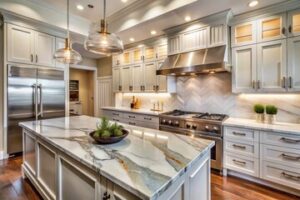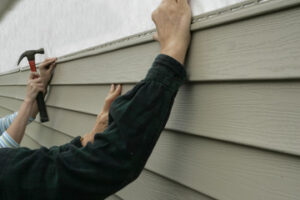Cabinet Refacing Sacramento CA is a cost-effective way to give your kitchen a facelift. Rather than replacing your cabinetry, it involves adding new doors and drawer fronts while covering the visible cabinet boxes with a veneer.

While refacing offers a fresh new look, it doesn’t address structural issues such as sagging shelves or water damage. If you’re looking to make significant changes to your kitchen layout, a full remodel is the best option.
Cabinet refacing allows homeowners to change the look of their kitchens without a full remodel. Whether you prefer a classical look or something more modern, there are plenty of options available to fit your tastes and budget. However, it is important to choose the right materials for your cabinets in order to ensure durability and an attractive finish. Low-quality materials can lead to durability issues and unattractive results. By choosing high-quality products, you can avoid these problems and ensure that your refacing project will last for years to come.
The most popular material for cabinet refacing is solid wood. This is a natural, high-quality material that provides a classy and timeless appearance. It is also fairly easy to clean and can be stained with a variety of different colors. However, it can be expensive and may require regular maintenance with special oils or polishes. Additionally, it is prone to damage from humidity and termites.
A less expensive option is plastic laminate. This is made from multiple layers of material that are fused together with heat and pressure. The top layer is typically kraft paper that has been printed with a design, such as wood grain. Then, a layer of resin is applied to seal the material. This type of refacing is durable and offers many color choices, but it does not have the same warm, natural appearance as solid wood.
Another option is medium-density fiberboard. This is a composite material that combines tiny wood particles with resin or glue and then is formed into boards. This is a cost-effective and durable choice for cabinet refacing that can be molded into various shapes and sizes. It is also resistant to water, stains, and scratches.
Refacing your existing cabinets with solid wood or one of these other materials is a great way to improve the look of your kitchen while still saving money compared to a complete remodel. It is also a sustainable and eco-friendly choice because it uses less material than new construction and diverts usable materials from landfills. In addition, refacing preserves the cabinet boxes and frames so they can be used again, rather than throwing away the old doors and drawer fronts.
Wood Veneer
Wood veneer is a thin “skin” of rare or costly wood applied to another material for aesthetic appeal. It’s often used on high-end furniture, such as that of Thomas Chippendale. Like solid wood, it can be stained, lacquered or painted to enhance its look. However, it is less durable than solid wood and is susceptible to moisture damage. It’s also prone to splintering if it’s exposed to harsh wear and tear, such as scratches or excessive heat.
It is a more cost effective material than solid wood, as one log can yield many veneer sheets. It is also significantly less labor intensive. This allows the use of rare or exotic species that wouldn’t be feasible if they were carved from solid wood.
Veneer production starts with careful selection of the best logs, focusing on those that are straight, free of knots, and with a uniform grain. The logs are then peeled or sliced, and then dried using jet dryers to reach the required moisture content. Quality control checks are carried out at each stage to ensure the highest standards.
Once the wood has been sliced, it is cut to size and then glued together to make panels. These are then spliced to form larger sheets. This is where the skilled craftsmanship comes in – this process requires considerable skill to achieve consistency and good colour matching.
The veneer is then sanded and treated with water repellent to protect it from moisture. It can be buffed or burnished to restore the original lustre and to give it a smooth surface.
The wood used in veneer is generally sourced from sustainable forests and is FSC certified. This demonstrates that the forest is managed according to rigorous environmental guidelines. However, the manufacturing process does generate some emissions of formaldehyde, so it is important to consider this when selecting a cabinet refacing supplier.
Rigid Thermofoil
Cabinet refacing offers an affordable, efficient way to refresh your kitchen’s aesthetic. It also reduces the amount of labor and materials needed for a complete remodel. However, it’s important to understand the limitations of this process. Unlike complete replacement, refacing cannot address issues with structural integrity or layout. It also doesn’t fix damage to the existing wood or materials.
A professional can help you evaluate the condition of your cabinets to determine if they’re suitable for refacing. They can also assist with design and style selections. Solid wood veneers accentuate rustic and traditional styles, while cabinets made from PVC vinyl can suit more contemporary aesthetics.
Refacing is a great option for Hillsboro homeowners that want to change the look of their kitchen without spending the money and time of a full remodel. But it’s important to consider the local climate when choosing material. Humid conditions can affect the longevity and durability of cabinet refacing materials. Moisture-resistant options like rigid thermofoil and laminate can hold up better in humid environments than wood-based materials.
Thermofoil is a durable, heat-resistant material that can be customized with different textures and finishes. It is usually bonded to medium-density fiberboard (MDF), but can be applied over other surfaces as well. Thermofoil is typically less expensive than solid wood or natural wood veneer. However, it can chip or peel over time, especially in high-traffic areas.
For a long-lasting, stylish appearance, homeowners should commit to tailored maintenance of their new cabinet surfaces. Wiping down veneers with mild cleaners, periodically polishing, and taking preventive measures against scratches and heat damage are all easy to do. These small steps ensure that your refacing project looks beautiful for years to come.
Adding decorative elements such as molding and trim to your refacing project adds more character and depth to your cabinet doors and drawer fronts. It’s best to negotiate package deals with your contractor to save on upgrade costs. You should also avoid relying on a single material for the entire project. Mixing up the materials you use can create a more unique, custom look for your kitchen.
Hardware
Cabinet refacing is a fast, affordable way to get the kitchen you want without the hassle of a complete renovation. This process updates the look of your existing cabinets by applying a new veneer to the exteriors, leaving the structure in place and offering a range of customizable options for the material and finish. It’s also more environmentally friendly than replacing the existing cabinets because it requires fewer new materials and uses less energy.
Most refacing projects use wood veneers as their base material, and these are available in many different types of natural and engineered wood. Popular choices include maple, oak, and cherry. These materials offer durability and beauty while providing strength, making them a great choice for high-traffic areas of your home. In addition, they’re easy to clean and stain resistant.
Another popular option for cabinet refacing is laminate. This material offers a wide variety of colors, patterns, and finishes and is easy to clean, making it ideal for high-traffic areas. It’s also very durable, able to withstand moisture and humidity while resisting chips and scratches. It’s a good choice for homeowners who want the look of wood or stone but are on a tight budget.
Before you decide to reface your cabinets, it’s important to evaluate the condition of your cabinet boxes and their compatibility with the new refacing material you’ve chosen. If the box has structural problems, a full replacement may be necessary.
Once you’ve decided to reface your cabinets, the first step is to remove old doors and drawer fronts and prepare the surface for application of the new material. The cabinet boxes are then cleaned and lightly sanded to ensure a seamless finish. We also take this opportunity to inspect for any water damage or soft spots that would affect the quality of your new veneers.
Next, the new cabinet doors and drawer fronts are ordered. Most cabinet refacing companies will custom-build these pieces to ensure an exact fit. This can be more expensive than buying ready-made cabinet doors and drawer fronts at a big box store, but it’s worth the investment for a long-lasting, beautiful look.
